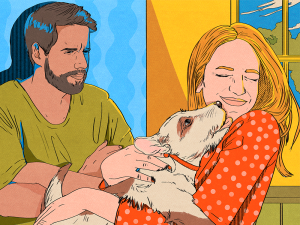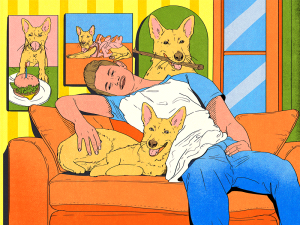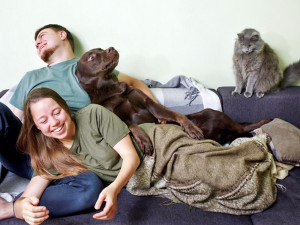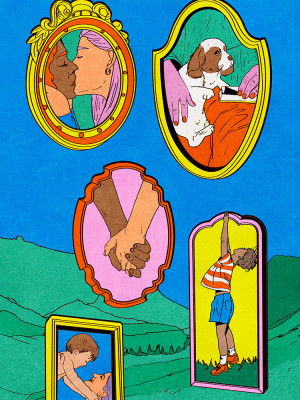
You and Your Partner Disagree on How to Parent Your Dog—What Now?
One person is a no-fuss type and the other spoils the pup silly. What’s the compromise?
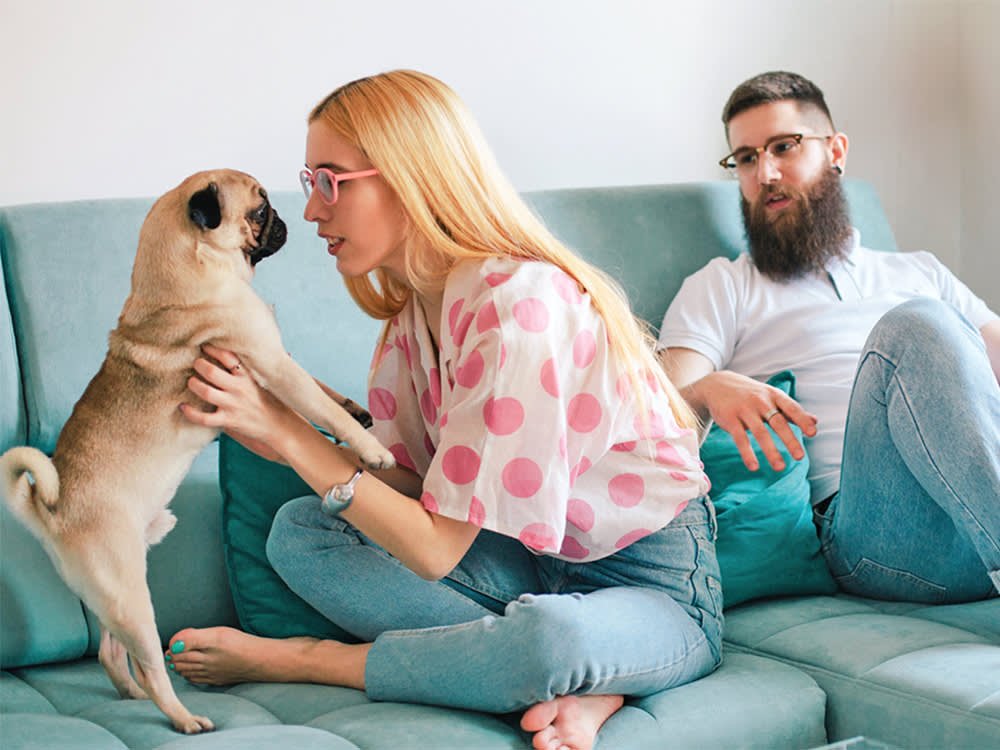
Share Article
Heavy Pettingopens in new tab is a biweekly column full of relationship advice for pet parents — so you and your boo don’t end up fighting like cats and dogs over the cat and dog.
I know of a couple — let’s call them Marcy and Darcy — who have an ongoing debate about dressing up their dog. Let’s call her Fancy. Fancy is, if you haven’t guessed, a fancy little French Bulldog. Marcy uses every holiday as an excuse to dress up Fancy — a pink scrunchie as a boa for Valentine’s Day, a Cleopatra costume for Halloween. Darcy, who is often tasked with trying to position Fancy for photographs, apparently does not like this practice.
They both think the other is being absurd. Marcy thinks it’s fun for Fancy to get this attention; Darcy thinks it’s only fun for Marcy to get this attention. The way it’s been described to me is that Fancy often scampers away from the selection of outfits set out before her. Meanwhile, Darcy wonders, “Who is this for?”
What happens when pet-parenting approaches don’t align?
Meghan Rydzewski, a therapist at the Council for Relationships,opens in new tab says this echoes a common conflict she sees in couples: “This is why it is important to discuss parenting styles before getting pets together or having children together.” Basically: If you’d rather avoid being an unpaid photo assistant-slash-dog costumer, it’s great to know ahead of time that your partner expects you to fill that role.
Rydzewski says she’s seen a handful of couples trying to resolve their different dog-parenting approaches. Rydzewski notes particular problems with “a partner who likes to give the pet table food, and the other partner is very strict on not wanting their pet to have table food.”
My own relationship is not without compromises regarding how we treat the dog, Finn — famously letting him jump up on our bed in the morning. But we’re both strict about preventing the dog from begging for human food, about giving him good walks. We both like practical, well-made, and aesthetically tolerable accessories and dog beds. While we’d love the idea of a Pendleton dog throw, we don’t want to be constantly combing away dog hair and having to lovingly care for expensive fabrics.
Neither of us has ever put Finn in a costume. While we don’t have moral problem with it, we’re generally not inclined. That one really boils down to “we can’t be bothered.”
Reparent yourself first.
Brett Bailey, a trainer with Who’s a Good Boy Industries,opens in new tab says that he encounters people with vastly different pet-parenting styles “every day, lol.” So has Mitchell Stern, a dog trainer with Yes Dog Trainersopens in new tab. Stern does training that emphasizes gentle connections with dogs.
And while he wants to avoid noting a gender stereotype, he says that, in his experience, “many men still subscribe to the old-school method of training, which includes fear, intimidation, and dominance — whereas the woman listens when I describe the benefits of partnership, respect, trust, and security with your pet. The men nod, but I know it’s a challenge to let go of past learnings.”
As a bonus nugget of wisdom, Stern also advises “couples who move in together to sit close to each other, like when watching TV on the couch. This signals the dog that both pet parents are together as a unit and oftentimes avoids favoritism.”
Give each other some grace.
Kelly Scott, a couple’s therapistopens in new tab with Tribeca Therapy, says, “I’ve worked with couples who have struggled with this exact issue.” She started working with this couple when they were considering moving in together. The boyfriend had one dog, the girlfriend had two.
Their struggles were about their dogs — but, in her therapist-minded opinion — “it wasn’t about the dogs. The dogs are symbolic, they are representing a whole lot more … There was something really important in a way that they really struggled to integrate the household and to essentially create a pack for their family.”
“It was almost like archetypes, how extreme and different each of them were,” Scott adds. “She would dress her dogs in coats; he was like, ‘Isn’t that what their fur is for?’ He was, like, a dry kibble kind of guy, and she had a freezer stocked full of like, personalized Farmer’s Dog, but on steroids. It had supplements, the whole nine yards.”
Scott goes on to add that the girlfriend was “someone who spent a ton of money on toys, doggie daycare, multiple walks a day, who felt very guilty leaving the dogs alone. She got that camera where you can interact with the dogs remotely and throw treats at them.” The boyfriend thought his girlfriend was overindulgent and had an attitude that boiled down to “dogs are dogs” and would often say something like, “‘I love my dog, but also, she’s fine. I don’t need to have a camera to watch my dog all day. Like, that doesn’t seem healthy.’”
In addition, he was afraid that if they moved in together, his partner would spoil his dog. Scott continues: “They were both really critical of the way that the other would do things.” So, she had them discuss logistics plans — regarding walks, and who was paying for things. She also had them talk through their logic about their parenting styles.
The girlfriend came from a difficult family situation, in which she was expected to take on a caretaker role from an early age, so giving her dog endless attention came naturally to her. Once learning this, her boyfriend started to have more compassion for her parenting style. Stern says this man came to view his girlfriend as someone “who had a lot of care and love to give and to think that his dog could actually really benefit from that. There was a relaxing on his part, as he allowed his dog to receive his girlfriend’s love and receive more care and attention.”
When it comes to this hurdle, I like the suggestion from Stern, the dog trainer, who often asks couples to “try on” a different approach to parenting. This framework is great; it gives people a way of really getting a feel for the way the other person looks at the world, to see the benefits and maybe the downsides of each other’s methods. It’s safe to say that trying on a different parenting approach sounds much better than trying clothes on your dog for two hours.

Maggie Lange
Maggie Lange is a writer, editor, and columnist. Her work has been featured in New York Magazine, Vice, Guernica, GQ, Rolling Stone, Pitchfork, Elle, and Bon Appetit. She lives in Philadelphia with her favorite brindle boy, Finn.
Related articles
Does Your Dog Hate When You and Your Partner Fight?
Here are the signs they’re trying to get you to stop.
![an illustration of a couple kissing, a dog, a couple holding hands, a child, and a child playing with a dog]()
Is Raising a Dog With Someone Anything Like Raising a Kid Together?
It’s the great puppy versus baby debate.
Should You Kick Your Pet Out of the Room When You Have Sex?
And what to do if you and your partner can’t agree on whether you should have an audience.
![an illustration of a cat inside a snowglobe]()
What Happens When the Love of Your Life Is Allergic to the Other Love of Your Life?
You don’t have to choose between your S.O. and your dog or cat — but here’s what may need to happen.
![an illustration of a cat with various cat chores: being groomed, scooping the litter box, feeding the cat]()
What to Do When Your Partner Isn’t Pulling Their Weight With Your Pet
So you don’t have to be annoyed anymore.
![a white dog stares up at a pink dress and yellow dress waving outside in the wind on a clothing line]()
When Is It Too Early to Get a Dog Together?
You’re in love, but is it irresponsible to add four paws to the mix? Here’s some input for your consideration.


